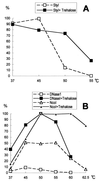Thermostabilization and thermoactivation of thermolabile enzymes by trehalose and its application for the synthesis of full length cDNA
- PMID: 9435224
- PMCID: PMC18452
- DOI: 10.1073/pnas.95.2.520
Thermostabilization and thermoactivation of thermolabile enzymes by trehalose and its application for the synthesis of full length cDNA
Abstract
The advent of thermostable enzymes has led to great advances in molecular biology, such as the development of PCR and ligase chain reaction. However, isolation of naturally thermostable enzymes has been restricted to those existing in thermophylic bacteria. Here, we show that the disaccharide trehalose enables enzymes to maintain their normal activity (thermostabilization) or even to increase activity at high temperatures (thermoactivation) at which they are normally inactive. We also demonstrate how enzyme thermoactivation can improve the reverse transcriptase, reaction. In fact, thermoactivated reverse transcriptase, which displays full activity even at 60 degrees C, was powerful enough to synthesize full length cDNA without the early termination usually induced by stable secondary structures of mRNA.
Figures



References
-
- Saiki R K, Gelfand D H, Stoffel S, Scharf S J, Higuchi R, Horn G T, Mullis K B, Erlich H A. Science. 1988;239:487–491. - PubMed
-
- Attfield P V. FEBS Lett. 1987;225:259–263. - PubMed
-
- Hottiger T, Boller T, Wiemken A. FEBS Lett. 1987;220:113–115. - PubMed
-
- De Virgilio C, Hottiger T, Dominguez J, Boller T, Wiemken A. Eur J Biochem. 1994;219:179–186. - PubMed
Publication types
MeSH terms
Substances
LinkOut - more resources
Full Text Sources
Other Literature Sources

